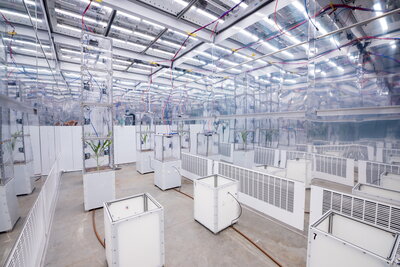
A new greenhouse custom-designed to support research at the Center for Advanced Bioenergy and Bioproducts Innovation (CABBI) is now open at the University of Illinois Research Park.
The Plant Biology Innovation Greenhouse (PBIG) features unique cutting-edge capabilities that are already benefiting plant and microbial science researchers on the U. of I. campus. It will propel research by CABBI — a $252M U.S. Department of Energy-funded Bioenergy Research Center – to develop an economically viable and ecologically sustainable domestic biofuel and bioproducts industry from dedicated bioenergy crops.
This innovative facility will allow CABBI researchers to monitor the growth and water use of next-generation bioenergy crops — automatically and in real time, said CABBI Director Andrew Leakey, Professor of Plant Biology at Illinois.
“This will accelerate development of crops that are more productive, sustainable, and resilient to climate extremes as part of our work to produce feedstock for sustainable aviation fuel and other bioproducts,” Leakey said at the Nov. 15 grand opening. “Second, it features special tracer-gas technology that can track how crops and microbes work together to sequester carbon and use nutrients in the soil.”

The greenhouse project was a team effort led by the U. of I. Provost’s Office, Department of Plant Biology, College of Liberal Arts and Sciences (LAS), College of Agricultural, Consumer and Environmental Sciences (ACES), School of Integrative Biology, and Department of Crop Sciences. Susan Martinis, Vice Chancellor for Research and Innovation, and Research Park Executive Director Laura Appenzeller also provided key leadership in the facility’s development and construction.
The benefits will flow across campus, with research and teaching opportunities for faculty and students across three colleges — LAS, ACES, and the Grainger College of Engineering — from experts in gene editing and plant physiology to artificial intelligence and crop breeding.
“This state-of-the-art facility is a testament to our commitment at this university to advancing research and innovation that addresses grand challenges in our world, sustainable energy solutions being among those. This greenhouse will provide researchers with the advanced tools and intellectual environment they need to continue to make valuable advances in their work,” said John Coleman, Provost and Executive Vice Chancellor for Academic Affairs at Illinois.
Undergraduates will also benefit through CABBI’s summer Research Internship in Sustainable Bioenergy (RISE), targeted at students from backgrounds underrepresented in STEM fields, Leakey said.
The greenhouse is home to a large high-throughput plant phenotyping facility and state-of-the-art walk-in growth rooms, with space for future expansion. A dozen early career researchers are already at work utilizing those capabilities.
“This is just the tip of the iceberg in terms of building a talent pipeline,” Leakey said.
The phenotyping facility, inside the three bays of the greenhouse, allows scientists to control growing conditions and study specific plant characteristics. The first experiment is centered on water use efficiency (WUE) in transgenic sugarcane, which has been engineered to reduce the number of stomata, or pores, on the surface of the leaves. Similar work with sorghum showed that decreasing stomatal density improved WUE without limiting photosynthesis or plant yield – findings that will aid crops in mitigating the effects of inadequate water supply.
The greenhouse experiment will provide data about WUE in the new transgenic sugarcane plants while allowing CABBI researchers to test the settings on the phenotyping system and gain experience with the new technology. Researchers hope to establish protocols for growing conditions, potting media, irrigation treatments, and other factors that keep CABBI crops growing in peak condition in the new facility.

In the mirror-lined growth chambers, mature sorghum plants were recently harvested from sealed plexiglass containers where they received water, light, and fertilizer for growth. The plants’ roots, leaves, and stems were examined to study their physiological traits and metabolites, microbial composition, and belowground carbon and nutrient dynamics. This initial study tested procedures for detecting differences in plant tissue metabolite profiles for future work comparing wild-type and oil-accumulating sorghum.
Researchers are already planting new sorghum seeds, to be fed isotopically labeled carbon dioxide. This will allow CABBI to explore carbon fluxes in crops, investigate linkages between plant-soil-microbial interactions and carbon fluxes, and gain an understanding of specific metabolic pathways of bioenergy crops — all to identify potential opportunities for crop improvement.
“We’re really excited about having this stable isotope facility because it allows us to deeply investigate the interactions between plants, microbes, and soil,” said Wendy Yang, Professor of Plant Biology and Geology and CABBI’s Sustainability Theme Leader.
“The studies that we conduct in this facility will allow us to better understand the ways that microbes can help confer resilience to our crops against climate change extremes. It will also allow us to better understand how the plant and soil microbe interactions will give us ecosystem service benefits, such as soil carbon sequestration.”
Leakey said the scientific discoveries, technological innovations and training opportunities that come out of the greenhouse will drive positive change for the bioeconomy and environment of the state of Illinois and nation.
Located on Fourth Street, just south of St. Mary’s Road, the greenhouse project was completed by Fox/Atkins Development and funded by the U. of I. CABBI’s Department of Energy grant provided funding for the growth chambers and phenotyping equipment.
The energy-efficient facility also features a solar array made possible by generous support from the Student Sustainability Committee at Illinois — a long-term investment in the facility and the environment, Leakey said.

